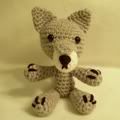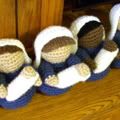 |
| Vanellope von Schweetz costume and Sugar Rush decorations |
 |
| Vanellope von Schweetz from Wreck-It Ralph |
 |
| Vanellope costume |
White Pullover Hoodie = $13
Rit Dye (Aquamarine and Kelly Green) $3 ea. x 2 = $6
Tulip Soft Matte Fabric Paint (Turquoise, Neon Green and Grape) $2 ea. x 3 = $6
Opaque White Tights = $8
Ponytail Wig = $12
1 lb. Sculpey Clay = $8
Hideous Pink Boots = $15
Brown Broadcloth Fabric 45 in. wide by 3 yd. x $2/yd (on sale) = $6
Lightweight Fusible Interfacing 20 in. wide by 6 yd. x $2.5/yd = $15
That totals out to $89, but once I add in all the little incidentals (thread, gummi bears, elastic, Sharpies, paint-on gloss coat, glue sticks), it was pretty much $100. And I'm not even figuring in all the money I wasted "experimenting," like when I tried to dye the tights instead of painting them or using RIT color remover to take out the first bad dye job I did on the hoodie (it didn't remove squat!). Hopefully you can learn from my mistakes and save yourself a little money.
***
 |
| Vanellope's hoodie |
Supplies:
- Fruit of the Loom White Pullover Hoodie (found in Walmart men's department)
- Rit Dye in Aquamarine and Kelly Green (I used the liquid dye)
- Mini glue sticks
- Pink Sharpie
- craft sticks (aka popsicle sticks)
- Gloss coat
- Fray Check
- Washing Machine (mine is a standard)
- Hot glue gun
- Scissors/exacto knife
Originally I tried to dye the hoodie in a bucket and it was a disaster. Even though I followed the instructions on RIT's website, the hoodie ended up splotchy and horrible-looking. There was not enough room in the bucket for the hoodie to get adequately dyed. I tried to remove the color so I could start over by using RIT color remover but it did nothing. I finally had to use bleach and that got most of the color out, though it was still a little yellow.
After that disaster, I decided to use the washing machine (mine is a standard top-loader). I was scared that I would end up coloring a subsequent load of clothes but I just ran a large load with bleach through after dying and I had no problems. Following the instructions from RIT's site, I ran a medium load with hot water on the longest agitate cycle I had (I think I had to turn the dial back a few times so it would agitate for at least 30 minutes as directed). After the hoodie went through the whole wash cycle, it came out looking great and exactly the color I was trying to get.
That leads me to to the big question you probably have: how much of each dye did I use? I'll tell you what I did but please understand that your situation may be different and you may get different results. I urge you to dye some test swatches of your fabric first - that's what I did and I discovered that the color mixture from RIT's site that I thought would be perfect was nowhere near the color I wanted.
I used the liquid dyes, one part RIT Aquamarine to one part RIT Kelly Green (so fifty-fifty, aka half and half). In my medium load in the washing machine, I believe (though I forgot to write it down, so I'm not 100% positive) that I used 4 ounces of each color (1/2 a cup of each) for a total of 8 ounces of dye. However, even if you do everything exactly the same as I did, there are several variables that could cause you to get a different color than the one I got with that mixture:
- My hoodie was 60% cotton, 40% polyester. RIT sticks to cotton better than polyester, so because my hoodie was only 60% cotton, that means I probably got a lighter color than I would've gotten had the hoodie been 100% cotton. Different cotton/polyester mixes would also give different results.
- How much water is in the "medium" load in your washer. I have no idea how much is in mine; if you have more or less water, your dye would be less diluted/more diluted and you could end up with a different color.
- If you use the powdered dye instead of the liquid your results could be different (I don't know what the powdered equivalent of the amount I used is).
How I made the drawstrings and stitches:
I struggled until pretty much the last minute trying to figure out how I wanted to make the drawstrings and stitches. When I was in the planning stages of the costume I watched Wreck-It Ralph several times and took screen captures of Vanellope's outfit and it looked to me like her hoodie's drawstrings and stitches were made of a translucent, pink, plastic-like candy. I have no idea what real-world candy would actually look like that - Twizzlers (like in her hair) aren't really that translucent. Anyway, I didn't want to use yarn or cording but I couldn't find ANYTHING clear, flexible, the right size and pink (or capable of being colored pink). I tried making silicone caulk strings, covering pink cord with hot glue, and using a straw as a mold for a string of hot glue (it just glued the straw together). Nothing looked right.
 |
| Drawstrings on the hoodie |
 |
| Stitches on the hoodie |
Attaching the drawstrings and stitches:
The drawstrings don't actually go all the way through the hoodie, they just stick out at ends. I hot glued them into the holes meant for the drawstring (I removed the drawstring that came with the hoodie before dying it). For the stitches, I cut holes in the hoodie where they belonged, touch up the holes with Fray check, let it dry (I didn't on the first hole and that's why some pink rubbed off on the hoodie) and ran the ends of the stitches through the holes. I hot glued each stitch to opposite ends of a popsicle stick (cut to about 2 inches long) on the inside of the hoodie. I did this so the stitches would appear curved on the outside of the hoodie.
 |
| How the stitches are attached on the inside |
***
 |
| Vanellope's skirt |
Supplies:
- ~3 yd. Symphony Broadcloth in Dark Chocolate (35 in. wide, from Joann's)
- ~6 yd. Pellon lightweight fusible interfacing (probably didn't use this much but I can't remember)
- Brown thread
- Elastic, ribbon or cord for waistband
- Sewing machine
- Iron
- Ironing board
- Scissors
- Starch (optional, helps make pleats stiffer)
Vanellope's skirt looks like two Reece's Peanut Butter Cup wrappers, layered on top of one another. I thought about using a shiny fabric to make the skirt look glossy like in the film, but I was concerned that the fabric would be damaged by the iron when I went to make the accordion pleats. Instead I used the cheapest fabric I could find - it was a 65% polyester, 35% cotton mix that I found in the quilting section.
I used the Circle Skirt Tutorial from danamadeit.com to find the right size for the skirt, to make a pattern for a 1/4 of the skirt and to cut out the skirt (I did not make the same kind of waistband as in the tutorial). I made the skirt short enough that I could cut the longer layer out from one piece of 45 inch fabric, instead of having to piece it together. The shorter layer was also cut from one piece of fabric, I just made it 4 inches shorter than the longer layer.
After cutting out my two giant circles, I followed AntiAiChan's tutorial on Youtube for making accordion pleats for a Vanellope skirt. I made my pleats wider than the ones in the video (I counted how many Vanellope's skirt had and aimed for a similar number). Bonus: larger pleats means less ironing!
I drew my pleats on the 1/4 skirt pattern which I then used to cut out pieces of interfacing (4 for each layer of skirt). The biggest time-saving tip I can tell you is to get a pencil or Sharpie and transfer the marking for your pleats from the pattern onto the non-sticky side of each piece of interfacing. This way you don't have to go back and do it after you iron it to the brown fabric.
I ironed the interfacing on to the inside of each layer of the skirt. The pieces didn't match up 100%, but it was close enough. I hemmed the lower edge of both layers and ran an overlock stitch over the top edge of them as well (but did not hem them). Still follower AntiAiChan's instructions, I ironed in all the pleats. I used spray starch while I was ironing but I'm not sure it made much of a difference. The weight of the interfacing is really what keeps the pleats sharp - don't use the featherweight stuff (I did for part of it and it did not hold the pleats as well). AntiAiChan used Pellon's Decor-Bond fusible interfacing so that may be the best way to go.
 |
| Drawstring waistband on skirt |
***
 |
| Vanellope's tights |
Supplies:
- White opaque tights
- Tulip Soft Matte Fabric Paint in Turquoise, Neon Green and Grape
- Painter's tape
- Cardboard mailing tube or duct tape leg
- Paintbrushes
- Dressmaker's chalk
- Ruler
The tights were the very last thing I made and they were nearly a disaster. When I dyed the hoodie, I experimented with using RIT dye on tights and I got a result that, though a bit light-colored, was okay. Unfortunately in the month that passed between when I did the test and when I sat down to do the tights (the day before the event), I completely forgot how I had applied the dye, how long I left it, how much I had diluted it...pretty much everything. But I thought I could figure out what I did and wasted most of the day experimenting. Everything I tried was a failure - the dye ran under the painters tape and most of it washed out afterward.
So lesson learned, RIT dye is not the best method for making striped tights. The next best thing I could come up with at the last minute was fabric paint. I had dismissed fabric paint earlier because I thought it might end up looking "crusty" or splotchy, but since I was running out of time I didn't have much choice. Luckily it turned out better that I thought. Though the paint was a little splotchy, it wasn't really noticeable once the tights were on.
I used this "Vanellope's tights" tutorial from pixiesizedprincess.tumblr.com as a starting point. The first thing I did was use a Sharpie to right "R" and "L" at the waistband of the tights so I wouldn't get them mixed up when I made my chalk markings while looking in the mirror. Vanellope's right leg has angled green and white stripes while her left leg has horizontal green, white and purple bands. I put on the tights, my skirt and boots and lightly marked where I thought the stripes should go with blue dressmaker's chalk. I took off the tights, stretched each leg over a cardboard mailing tube (one at a time) and used a ruler to redraw my marking so they were evenly spaced.
When I was ready to paint, I used painter's tape to mask off the parts I wanted to stay white. I used the Grape paint as-is and mixed together the Turquoise and Neon Green fabric paint to get the green color I wanted (no clue about the exact proportions - all I can say is that I used most of the bottle of Neon Green and not as much of the Turquoise). Contrary to what the tutorial said, I watered the paint down a little because it wasn't spreading like I wanted. That did result in a little bit of running, though, so it might not have been a good idea. After letting the first leg dry completely, I repeated everything on the other leg.
 |
| Vanellope's tights |
- Obviously I wish I hadn't wasted a day trying to make the RIT dye work!
- I wish I had had time to make a duct tape model of my leg like in the tutorial and had to use a cardboard mailing tube. The fabric paint dries very stiff and the tights end up stretched to the width of whatever you had them on when you painted them. Since I used the mailing tube, this meant that my tights were baggy in the ankle and so-tight-I-could-barely-get-them-up around the thigh. In the end they still worked, but a duct tape leg would've solved those problems.
- The paint stuck to the cardboard when it dried, so when I tried to peel it off the mailing tube I ended up with little pieces of paper stuck to the inside of my tights! It was a giant pain to clean up. Possibly something slick underneath liked waxed paper (or duct tape) might've stopped that, but I didn't have time to experiment and was worried that a slick surface under the tights might make the paint bleeding worse.
- The Neon Green Tulip Soft Matte Fabric Paint had glitter in it. It was the only shade of green at the store that was anywhere near what I needed so I used it anyway, but the glitter rubbed off on everything and made a mess. A non-glitter paint would've been better.
***
 |
| Boot altered to look like Vanellope's (original boot in the background) |
Vanellope's boots are shiny, black, laceless boots with red licorice stuck to the soles. I had a hard time finding something that looked anything like that for under $20. Eventually I got lucky and found a hideous pair of black slippers with pink bows, pink faux-fur lining and pink soles at Walmart for $15. I removed the bows and I carefully detached the fur lining from the top of the boot so it could be tucked inside. I didn't remove it completely because it was attached to the rest of the interior lining and without it the boots would've been uncomfortable to wear. I used a black Sharpie to draw over the pink stitching on the boots and a red Sharpie to color in the edges of the pink soles so they would look like the red licorice. I wish yet again that I had thought to use a waterproof gloss coat over the red Sharpie because I discovered afterward that some of it had rubbed off on my tights (I guess when I accidentally touched them with the edge of the boot).



















